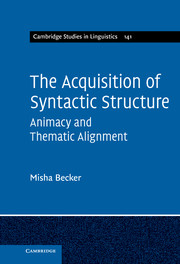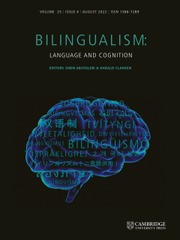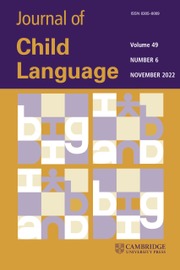The Acquisition of Syntactic Structure
This book explains a well-known puzzle that helped catalyze the establishment of generative syntax: how children tease apart the different syntactic structures associated with sentences like John is easy/eager to please. The answer lies in animacy: taking the premise that subjects are animate, the book argues that children can exploit the occurrence of an inanimate subject as a cue to a non-canonical structure, in which that subject is displaced (the book is easy/*eager to read). The author uses evidence from a range of linguistic subfields, including syntactic theory, typology, language processing, conceptual development, language acquisition, and computational modeling, exposing readers to these different kinds of data in an accessible way. The theoretical claims of the book expand the well-known hypotheses of syntactic and semantic bootstrapping, resulting in greater coverage of the core principles of language acquisition. This is a must-read for researchers in language acquisition, syntax, psycholinguistics and computational linguistics.
- Provides an answer to a well-known puzzle in syntactic theory and exposes readers to a learnability puzzle that served as a main catalyst in the establishment of generative syntax
- Draws on evidence from a range of linguistic sub-fields and will be of interest to readers with different areas of expertise
- Presents computational models of language learning, which represent a new advance in language acquisition research and are accessible to non-computationalists
Reviews & endorsements
"This book is a major milestone for acquisition research in the "strict" sense: what exactly does the adult know, and how do children acquire that knowledge? Becker is conversant with an unusually broad range of disciplines, including generative grammar, developmental psychology, and computational modeling. This enables her to support the book's central thesis - that children use animacy cues for detecting syntactic displacement - with strong, converging evidence from cross-linguistic comparisons, adult psycholinguistics, Bayesian models, transcripts of child-directed speech, and laboratory experiments with children."
William Snyder, Linguistics and Cognitive Science, University of Connecticut
Product details
May 2014Hardback
9781107007840
342 pages
229 × 155 × 23 mm
0.63kg
32 b/w illus. 26 tables
Available
Table of Contents
- 1. Introduction
- 2. The syntax of displacing and non-displacing predicates
- 3. Argument hierarchies
- 4. Animacy and adult sentence processing
- 5. Animacy and children's language
- 6. Modeling the acquisition of displacing predicates
- 7. Conclusions and origins.








